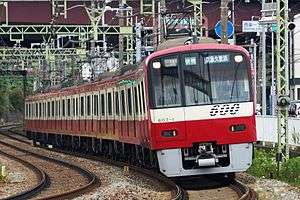Keikyu 600 series
| Keikyu 600 series | |
|---|---|
 600 series set 607 in May 2017 | |
| Manufacturer | Tokyu Car Corporation, Kawasaki Heavy Industries |
| Replaced | 1000 series |
| Entered service | 1994 |
| Refurbishment | 2009– |
| Number built | 88 vehicles (14 sets) |
| Number in service | 88 vehicles (14 sets) |
| Formation | 4/8 cars per trainset |
| Operator(s) | Keikyu |
| Specifications | |
| Car body construction | Aluminium |
| Car length | 18,000 mm (59 ft 1 in) |
| Width | 2,830 mm (9 ft 3 in) |
| Doors | 3 pairs per side |
| Maximum speed | 120 km/h (75 mph) |
| Traction system | Variable frequency (GTO) |
| Electric system(s) | 1,500 V DC |
| Current collection method | Overhead catenary |
| Track gauge | 1,435 mm (4 ft 8 1⁄2 in) |
The Keikyu 600 series (京急600形) is an electric multiple unit (EMU) train type operated by private railway operator Keikyu on commuter services in the Tokyo area of Japan since 1994. They were introduced to replace the ageing 1000 series sets on limited express services.[1]
Formations
As of 1 April 2016, the fleet consists of eight eight-car sets and six four-car sets (classified 650 series).[2]
8-car sets
The eight-car sets 601 to 607 are formed as follows, with six motored (M) cars and two trailer (T) cars.[2]
| Designation | M1c | M2 | Tu | Ts | M1' | M2 | M1 | M2c |
|---|---|---|---|---|---|---|---|---|
| Numbering | 60x-1 | 60x-2 | 60x-3 | 60x-4 | 60x-5 | 60x-6 | 60x-7 | 60x-8 |
- The "x" in the car numbers corresponds to the set number.
- The "M1c" and "M1" cars are each fitted with one lozenge-type pantograph, and the "M1'" car is fitted with two pantographs.[2]
The eight-car set 608 is formed as follows, with four motored (M) cars and four trailer (T) cars.[2]
| Designation | Muc | T | Tp1 | Mu | Ms | T | Tp1 | Msc |
|---|---|---|---|---|---|---|---|---|
| Numbering | 608-1 | 608-2 | 608-3 | 608-4 | 608-5 | 608-6 | 608-7 | 608-8 |
The two "Tp1" cars are each fitted with two single-arm pantographs.[2]
4-car sets
The four-car sets are formed as follows, with two motored (M) cars and two trailer (T) cars.[2]
| Designation | Muc | T | Tp2 | Msc |
|---|---|---|---|---|
| Numbering | 65x-1 | 65x-2 | 65x-3 | 65x-4 |
The "Tp2" car is fitted with two single-arm pantographs.[2]
Liveries
Set 606 is painted in a special "Blue Sky Train" livery.[2]
- Set 601 in original colour scheme in July 1995
 Set 651 in later livery in June 2010
Set 651 in later livery in June 2010 Refurbished set 602 in July 2010
Refurbished set 602 in July 2010.jpg) Set 606 in "Blue Sky Train" livery in June 2017
Set 606 in "Blue Sky Train" livery in June 2017
Interior
The first batch of sets introduced featured transverse facing seating bays throughout, but later sets featured longitudinal seating, and from 2004, the earlier seats were also modified with some transverse seating bays replaced by longitudinal seats.[1]
- Interior view showing transverse seating in September 2010
- Interior view showing longitudinal seating in September 2010
References
- 1 2 私鉄車両年鑑 2012: 大手15社営業用車両完全網羅 私鉄車両年鑑2012 [Japan Private Railways Annual 2012]. Tokyo, Japan: Ikaros Publications Ltd. February 2012. p. 121. ISBN 978-4-86320-549-9.
- 1 2 3 4 5 6 7 8 私鉄車両編成表 2016 [Private Railway Rolling Stock Formations - 2016] (in Japanese). Japan: Kotsu Shimbunsha. 25 July 2016. p. 35. ISBN 978-4-330-70116-5.
External links
| Wikimedia Commons has media related to Keikyu 600 series (III). |
- Keikyu 600 series official information (in Japanese)
